Our Blog - Paris January 2018 - Day 4
We took this day to go to Chartres. Mind you, we've been to Chartres before, but it is a nice little town with a great Cathedral and so it is always worth another trip. It is only 60 miles from Paris and it is a quick trip by train. The town itself dates back at least to 858, when it was burned by the Normans. During the Hundred Years' War, Chartres fell into the hands of the English (in 1417) and it moved back under French rule in 1432. On Sunday, 27 February 1594, the cathedral of Chartres was the site of the coronation of Henry IV after he converted to the Catholic faith, the only king of France whose coronation ceremony was not performed in Reims.
During WW II, Chartres was heavily bombed, but the cathedral was spared (thank goodness!). Interestingly enough, it was an American who ended up saving the cathedral. The city suffered heavy damage by bombing and during the battle of Chartres in August 1944, but its cathedral was spared by an American Army officer who challenged the order to destroy it. Colonel Welborn Barton Griffith, Jr. questioned destroying the cathedral and volunteered to find out if the Germans were using it as an observation post. After searching the entire cathedral, he confirmed to HQ that it was not under German control and the order to destroy the cathedral was withdrawn. Unfortunately, he was killed in action later on that day about 2 miles north of Chartres. But for those of us who have enjoyed the cathedral, his death was not in vain.
Here we start just up the street from the train station, with a large sign with the name Chartres and the cathedral in the background. The current cathedral was built between 1194 and 1220, but a church has occupied this site since the 4th century. It is a Gothic church, with heavy flying buttresses. As noted, the cathedral was not bombed and the majority of the original stained glass windows survive intact. One thing that you can see is that the two spires have different styles. The one on the right is the earlier one, a plain pyramid finished in 1160 and topping out at 349 feet. The one on the left is taller, 377 feet, and was completed in the early 16th century in a Flamboyant Gothic style. You can also clearly see how the center part, with the rose window, looks very clean compared to the spires. They have been doing restoration work for many years, and so there are parts that are VERY clean and others that are quite dirty. The last picture was taken while we were walking, but you can see how the cathedral sits up on a hill and dominates the town.




But we'll get back to the cathedral a bit later as first we'll head through town for a few of the other sights. Just up from the train station is the Monument aux Morts of 1870, and was erected in 1901. Normally, we see these monuments for WWI (mainly) but this is specifically for those from the area of Eure-et-Loir who died during the Franco-Prussian War. Under the arch is a bronze sculpture representing the French Republic with a wounded soldier at his feet threatening the enemy. The monument is framed, on the left, by the statue of a gunner and on the right, by that of an infantryman.

The Fine Arts Museum is housed in the former Bishop’s Palace, which was originally built in the 12th century and was where Henri IV was coronated (1594) and where Napoleon lived in 1811. The garden was laid out in the 17th century with a labyrinth. It normally has great views of the city although today, it was a bit cloudy.




The covered market has the sign "Marche aux Legumes" or the vegetable market. Obviously, no market on the day that we were there, but it is a really nice glass and metal cover. This is different than the markets in Toulouse in that it is covered but open (no doors) while the ones in Toulouse either are open air (no cover) or basically within a building.

In addition to the cathedral, there are 2 other churches in the town that we visited. The first was St. Aignan Church. Like many older churches, there are bits and pieces from churches throughout different centuries as the churches were damaged (mainly by fires) and rebuilt. In this case, the doorway that you see in the "middle" under the large windows dates back to the 14th century. This is a very plain and simple entrance, which is a bit odd since many churches have elaborate entrances. In this case, there were houses that were built all around the church and there was only a small, narrow passage between the houses and church, so you couldn't really see the entrance all that well anyway. Now that the houses are gone and the large place is there, it seems a bit odd.
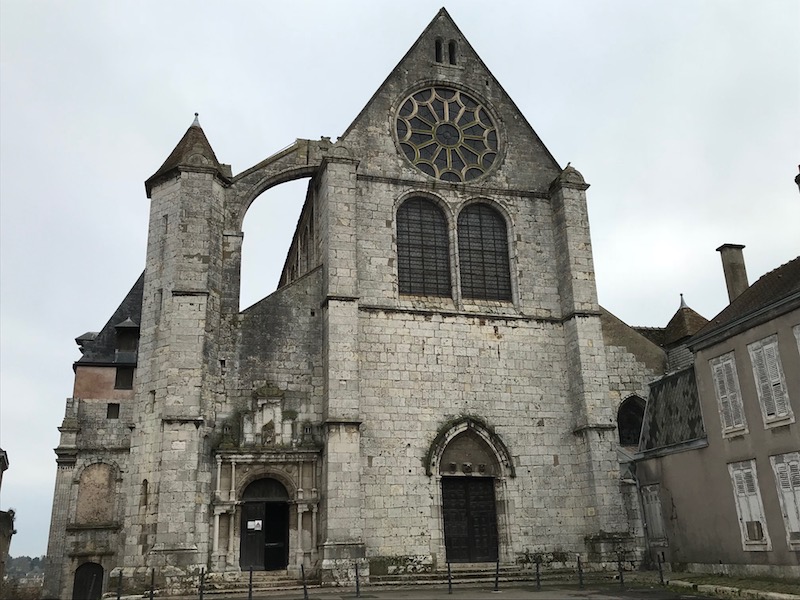
The interior of the church is also quite unique. The main nave was designed to have a stone vaulted ceiling, which explains the cluster of large columns on both sides of the nave (which would have been required to hold such massive weight) and the flying buttresses outside. However, work was interrupted before they got the roof added and it was quickly covered with what was meant to be temporary. In 1625, a more permanent, wooden roof was added although it has an ornate design which makes up for the fact that it is a wooden roof instead of the expected stone vaults. You can also see the Gothic arches between the column clusters, and also see how colorful the interior was.
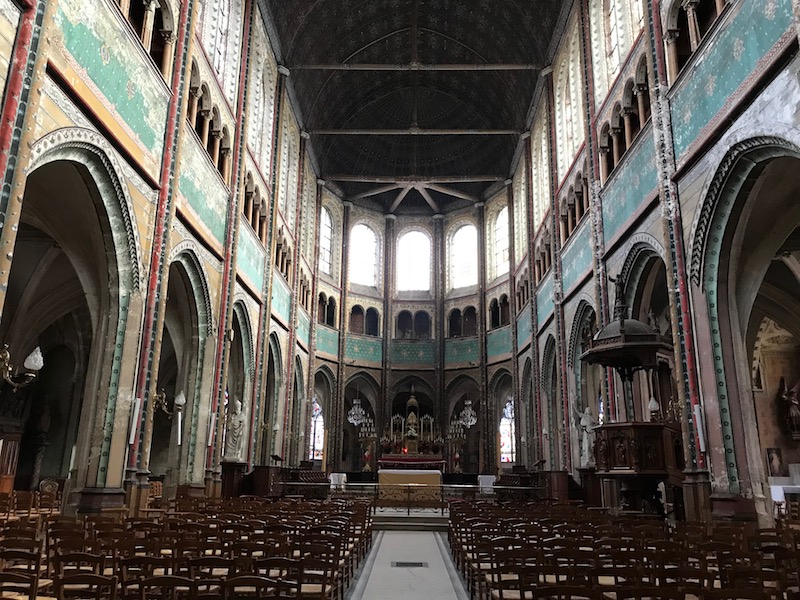

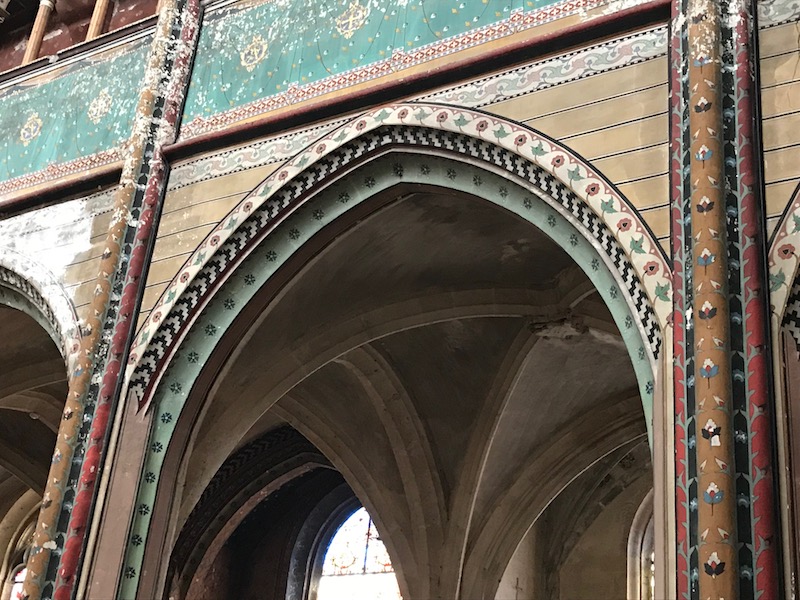
And I'm sure you know you wouldn't see a church without the stained glass windows! Some of the windows date back to the 16th century. The first picture shows the 4 bishops Saint Martin, Saint Denis, Saint Aignan, and Saint Nicolas.
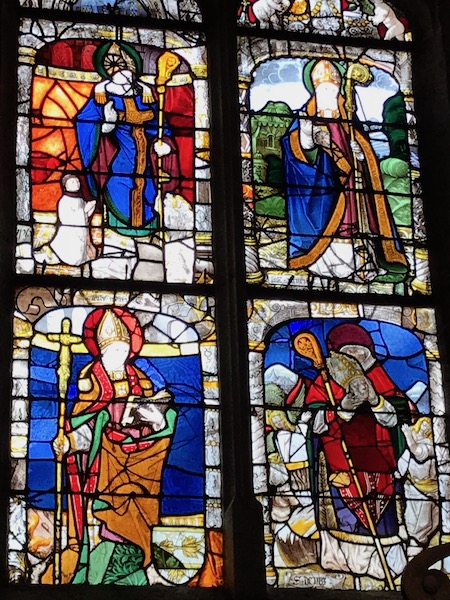
This window has a slightly different style than the others, as it has very strong colors and is characteristic of the Renaissance period inspired by the Italian painter Raphael.
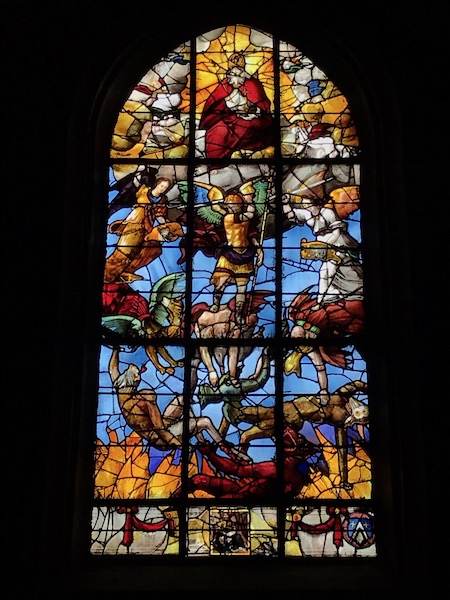
And a few last ones ... the last supper and then Saint Ignatius of Antioch (martyred by being thrown to the lions in the Colosseum). In the corner of the 2nd, you may be able to make out "Lorin 1888". Maison Lorin is a stained glass factory in Chartres that has been doing stained glass since 1869.
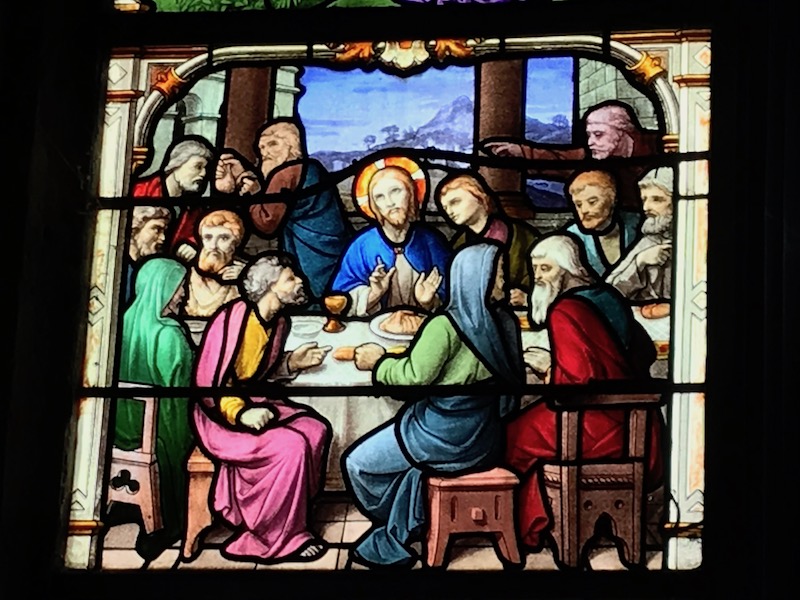
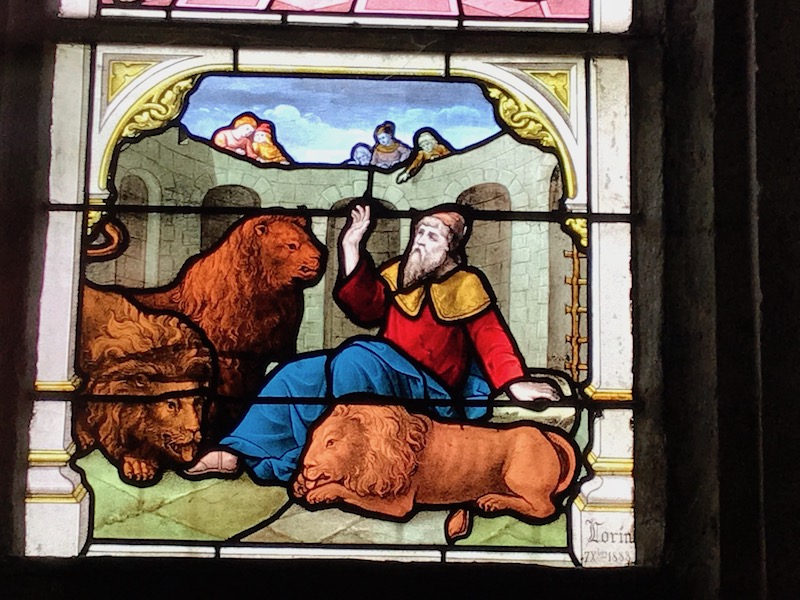
Next was the Church of St. Pierre, a massive church with Gothic flying buttresses that used to be part of a Benedictine monastery. The plain, square bell tower on the very right is the oldest part and dates back to the year 1000. You can see that it has very few openings and the ones that it has are tall and narrow, which were defensive openings used to defend the monastery from attack. Since the monastery was built outside of the city defensive walls, it was vulnerable to attacks. The majority of the church dates to the early 13th century although there are bits and pieces from earlier 10th, 11th, and 12th century churches that were destroyed by fires.
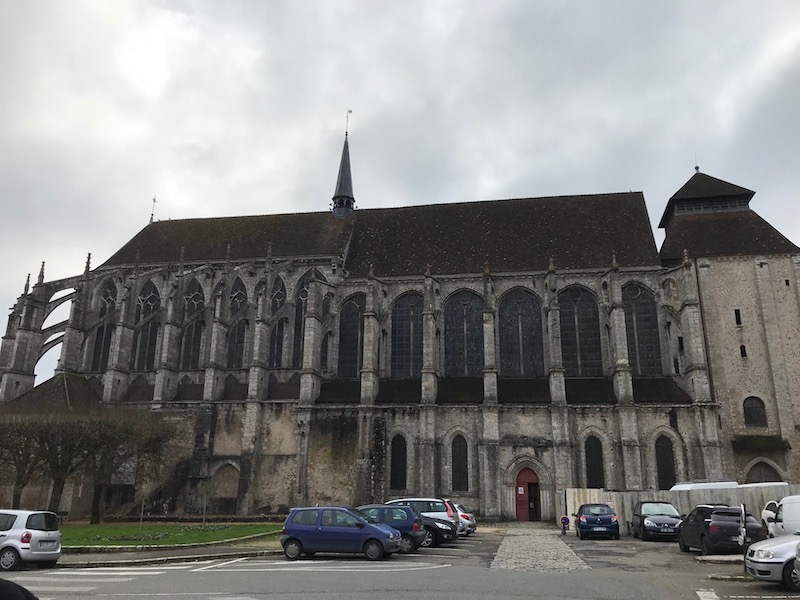
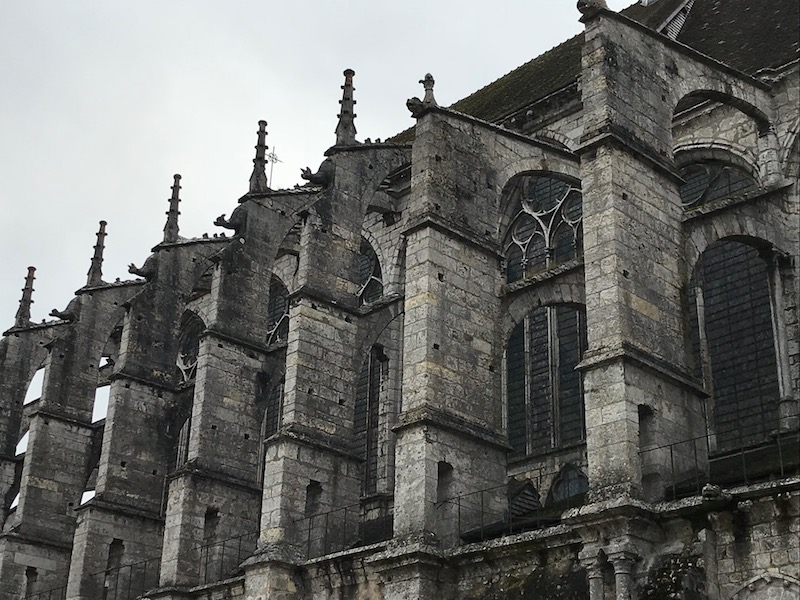
The interior is much like what you would imagine: tall gothic arches between massive column clusters used to support (along with the buttresses) the very high vaulted stone ceiling. Stained glass windows sit between each of the arches in the top part of the nave. The stained glass dates to the mid 13th and early 14th century. You can see one that has dark blue stained glass with grey almost clear glass between (3rd picture). These are called "grisaille" panels (which translates to grayness) and they allows for more light to come into the church (since the darker panels would not allow as much light to pass through). The figures on the North side panels are those for Saint John the Baptist and the apostles, and the South side is reserved for abbots, bishops, and popes.
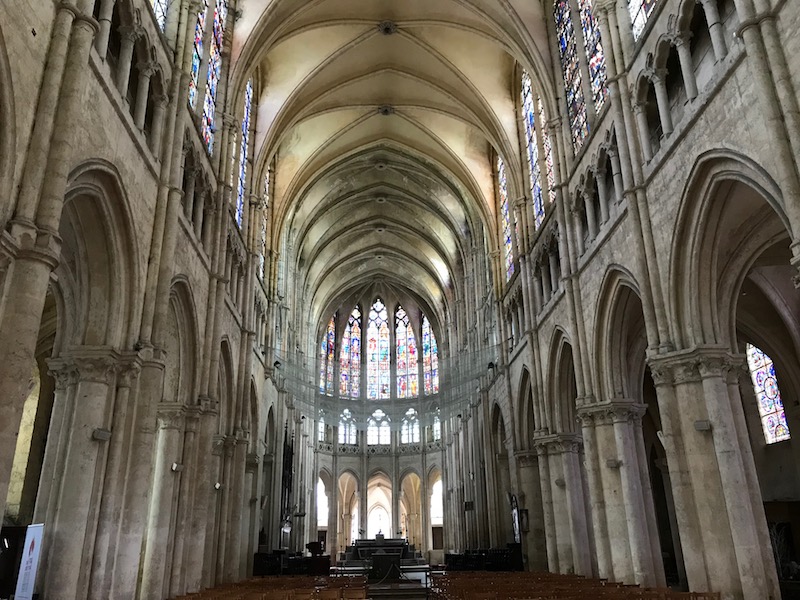
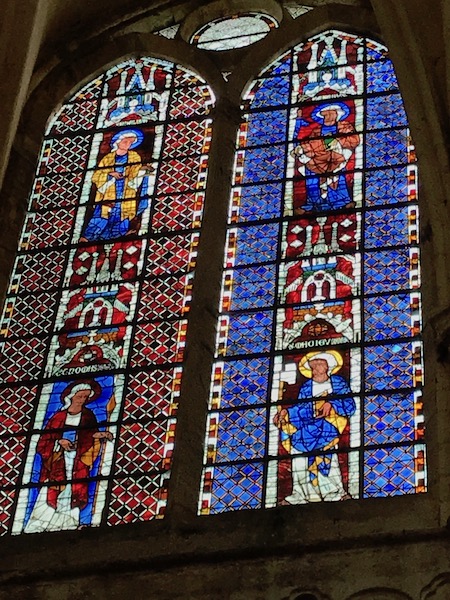
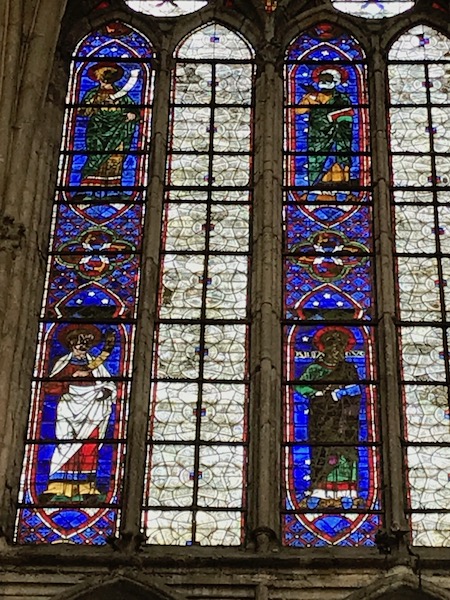
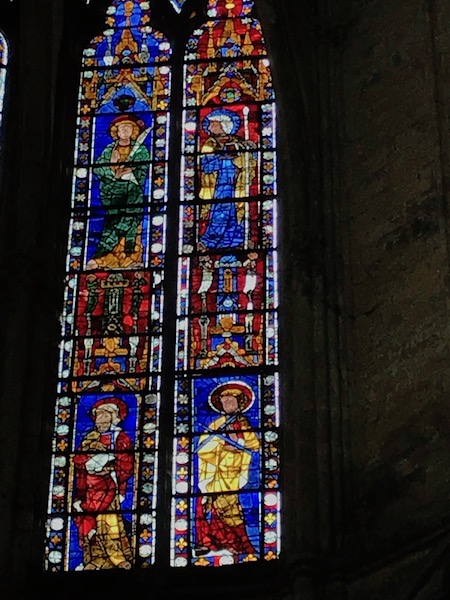
Now, back to the main attraction, the cathedral. It is *the* reason most people travel to Chartres, and for good reason. It is a great example of high Gothic architecture ... original stained glass windows, heavy flying buttresses, and 3 different entrances, each with hundreds of sculpted figures illustrating key theological themes and narratives.
The West entrance, sometimes known as the Royal Doorway, is the oldest entrance and one of the few elements to survive from the mid-12th century church. The tympanum over the central door, shown here, has Christ seated within a mandorla (that almond-shaped outline around him) with the four winged creatures that symbolize the Four Evangelists around him: Matthew the man, Mark the lion, Luke the ox, and John the eagle. Below this in the lintel, you can see the 12 apostles (in groups of 3) and above in the archivolts are the 24 Elders of the Apocalypse. The last picture shows something that I don't know that I knew before (but they explained on the audioguide) ... in the Middle Ages, the cathedral also functioned as a school. Surrounding the tympanum, as a reminder of the glory days of the School of Chartres, the archivolts are carved with some very distinctive personifications of the Seven Liberal Arts as well as the classical authors and philosophers most associated with them. You can make out (maybe) that the bottom left one is Pythagoras who is credited with many mathematical and scientific discoveries (like the Pythagorean theorem that we all had to learn in high school).

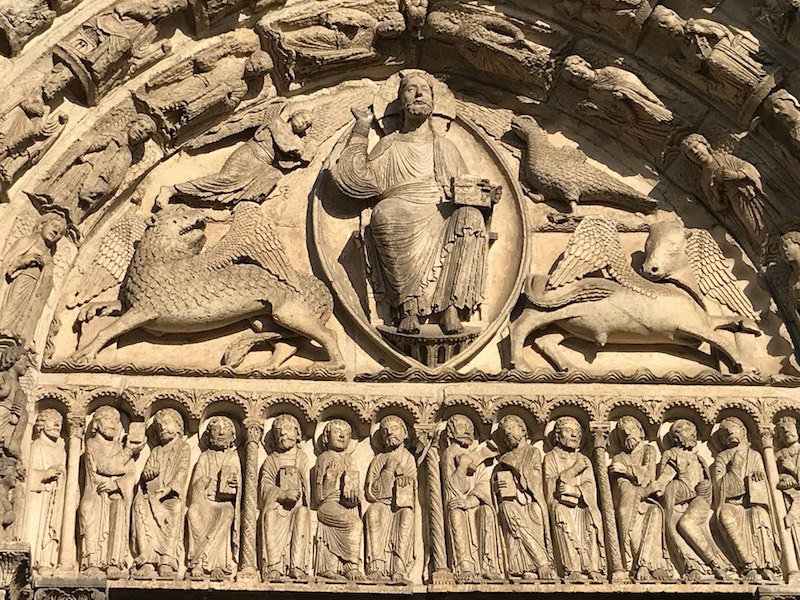
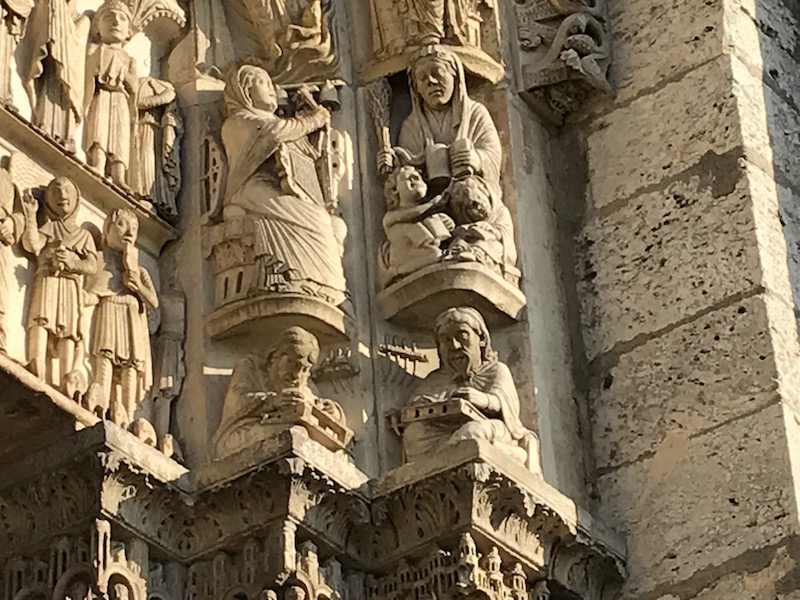
In northern Europe, it is common for the iconography on the north side of a church to focus on Old Testament themes, with stories from the lives of the saints and the Gospels being more prominent on the physically (and hence, spiritually) brighter southern side. Chartres is no exception to this general principle and the north transept portals concentrate on the precursors of Christ with a particular emphasis on the Virgin Mary. Here you can see the central portal on the North side, with the Assumption of the Virgin Mary after her death, and then Mary seated with her son Jesus in the tympanum.


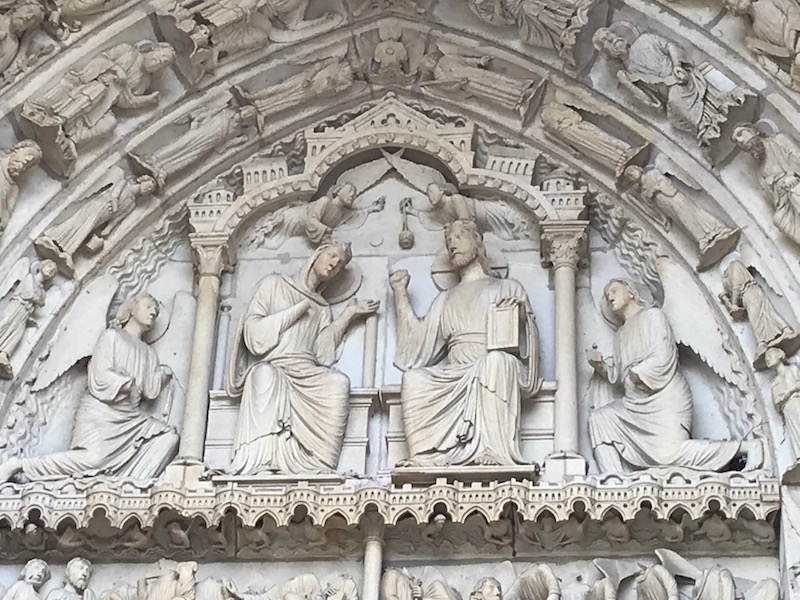
The jamb statues include (2nd picture) Melchizedek, Abraham with Isaac, Moses, Samuel, and David, (3rd picture) Isaiah, Jeremiah, Simeon with Jesus (on his arm), St. John the Baptist, and St. Peter.
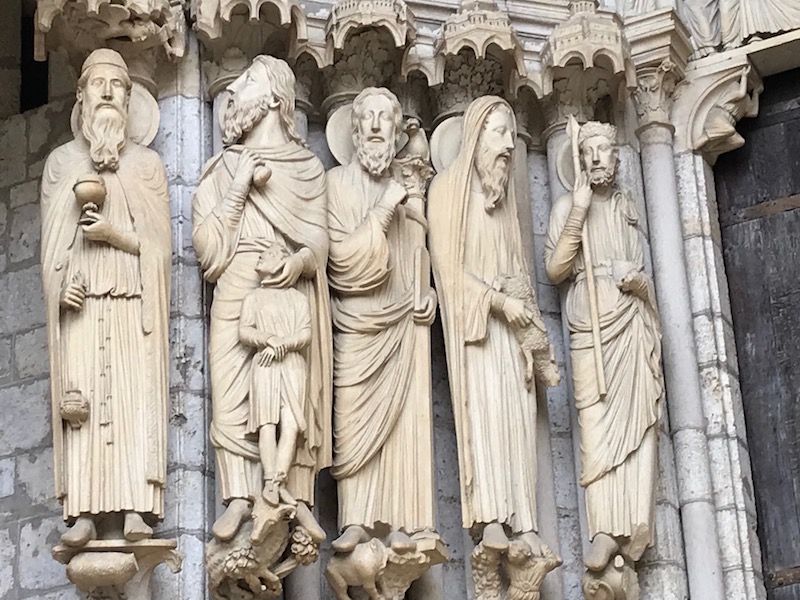
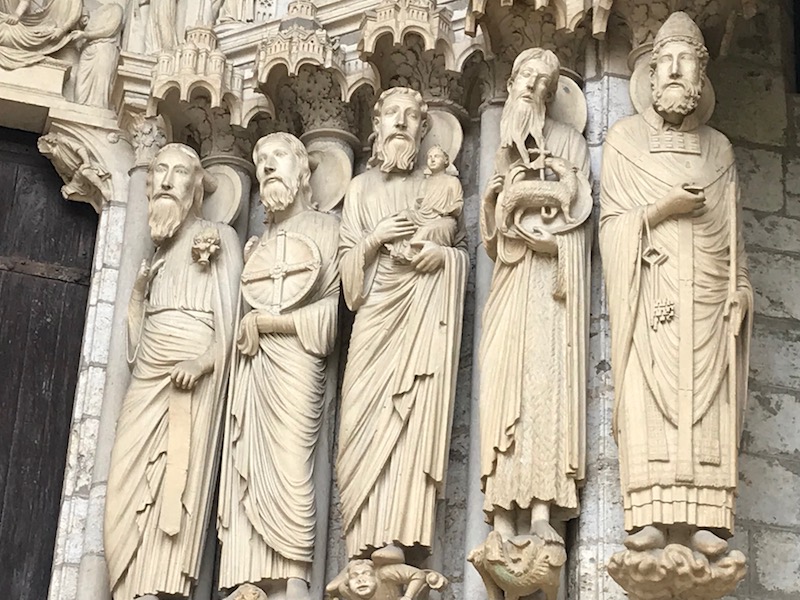
The South portal addresses the time from Christ's death until his Second Coming. The central portal concentrates on the Last Judgement and the Apostles, the left portal on the lives of martyrs and the right on confessor saints. I've included a picture of am engraving of the South portal made around 1850. The Jamb figures shown here from the left portal on the South are those of Martyr saints. Here you can see St. Theodore (2nd photo on the left) who was a Roman soldier who converted to Christianity and became a saint (here represented as a Christian knight).
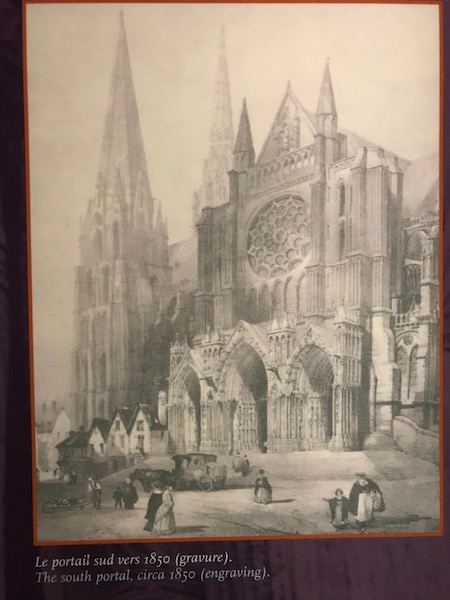
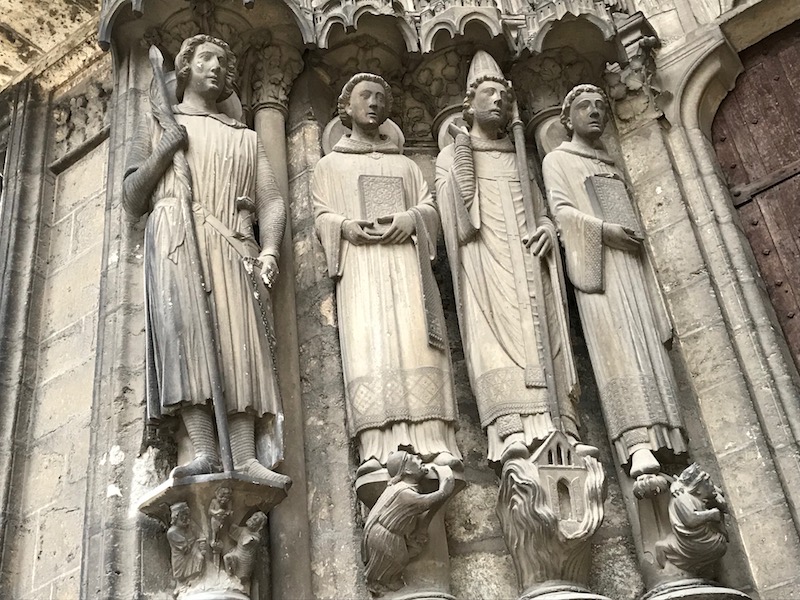

The interior plan is that of a cruciform, which means that the nave and transepts form a cross. The nave itself is 3-stories tall, which you can see here with the ground floor having the columns and tall gothic arches, then the 2nd story between the gothic arches and the windows, which has a more Renaissance/Romanesque design, and then the 3rd story with the windows. Looking down the nave towards the altar, you can see the 18th century status in the choir of the Assumption.



One thing that I wanted to show was the restoration that has been going on. You may have been able to tell on the jamb statues on the exterior portals that some were really clean and others weren't. The restoration is looking to not only to clean and maintain the structure, but also to offer an insight into what the cathedral would have looked like in the 13th century. Some of the critics of the restoration have argued that the increase in ambient light, reflecting off the painted surfaces, diminishes the impact of the stained glass. The soaring arches, ribs and columns have been scrubbed to reveal their original bony white. The elaborately carved keystones that hold the roofs together have been repainted to a gleaming red, green, black and gold, based on fragments of the medieval paint that has survived. These I think give a good example of the before and after ... in the first, you can see the very top of the bottom columns and the gothic arches and vaults have been restored, but that is above it has not, and they are the dirty, dingy blackish color. I also showed one keystone before the paint restoration and one after. The last picture shows the painted vaults on the 2nd floor.
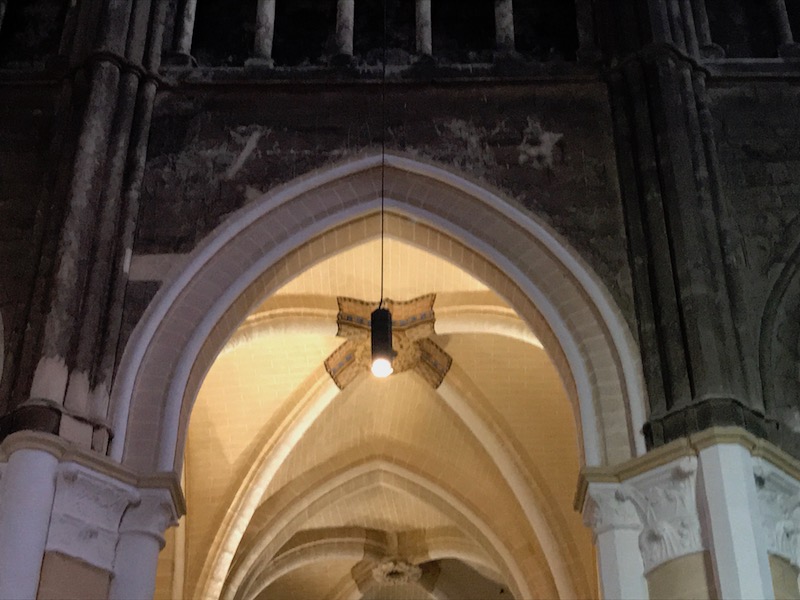

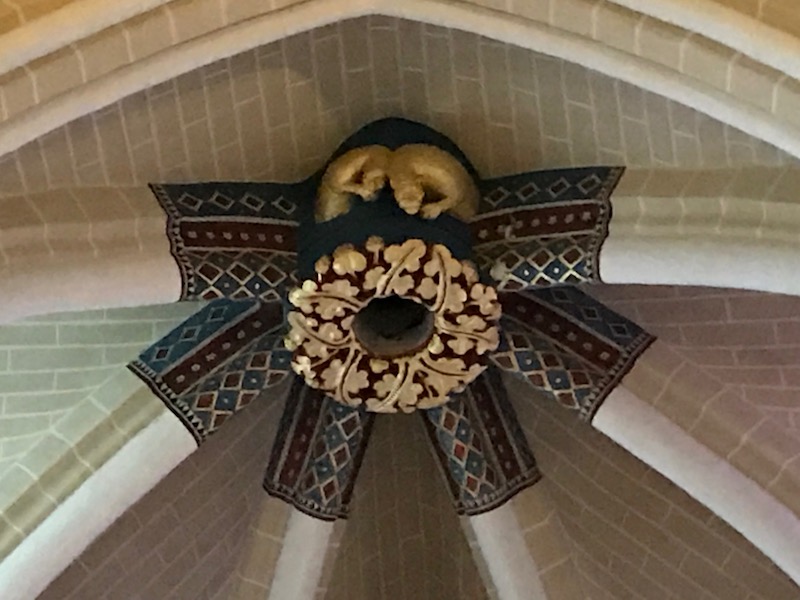

The choir screen itself is a magnificent example of flamboyant gothic style. Integrated in the screen are 40 sculpted reliefs of biblical scenes, and other scenes from the life of the Virgin Mary. It actually starts chronologically with the birth of Mary. The scenes were sculpted by multiple artists over a 200 year period from 1510 to 1720. If you visit, get the audioguide and one part of the audioguide actually explains each and every one of the 40 scenes. You can also see the difference between scenes that have been restored and those that have not.
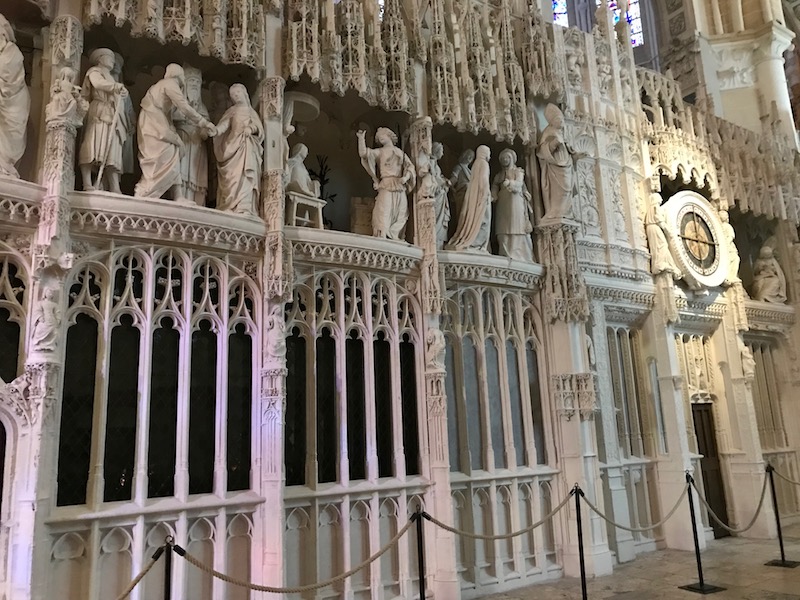
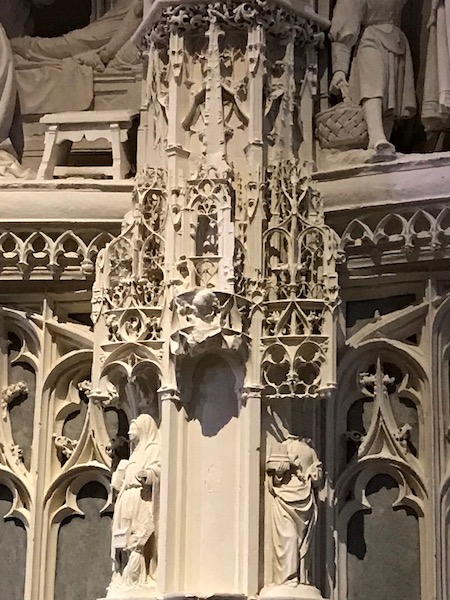
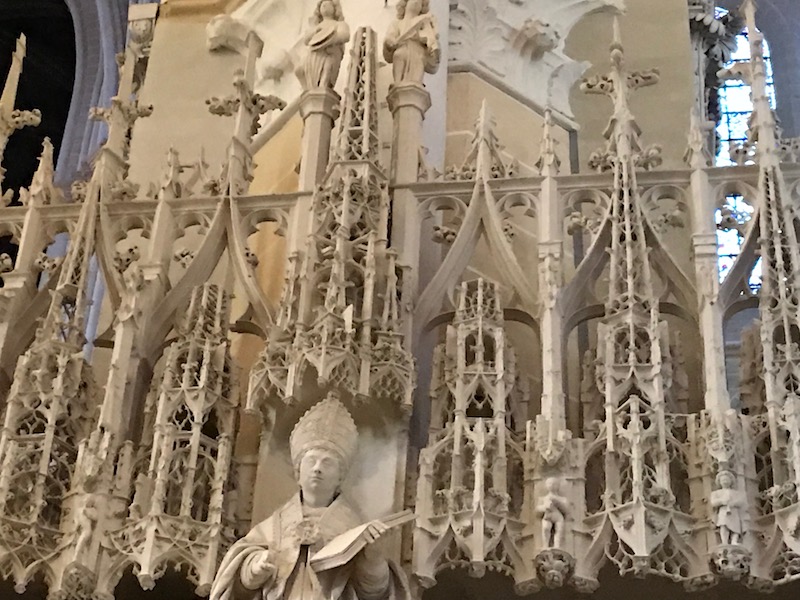
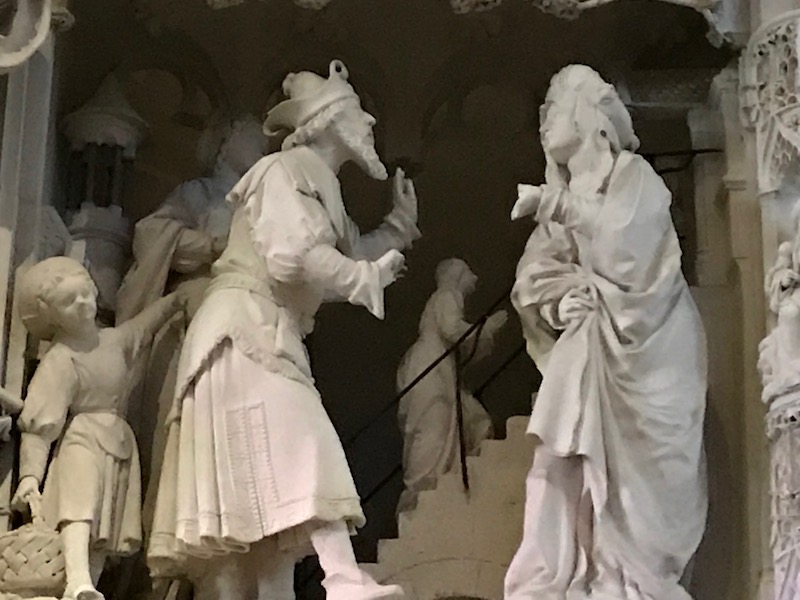



This polychrome statue is named "Our Lady of the Pillar". It was sculpted in the 16th century of pear wood, and placed upon a pillar (hence the name). The wooden neo-gothic style wooden structure was added in 1830 and the crown was added in 1855 during the papacy of Pope Pius IX.
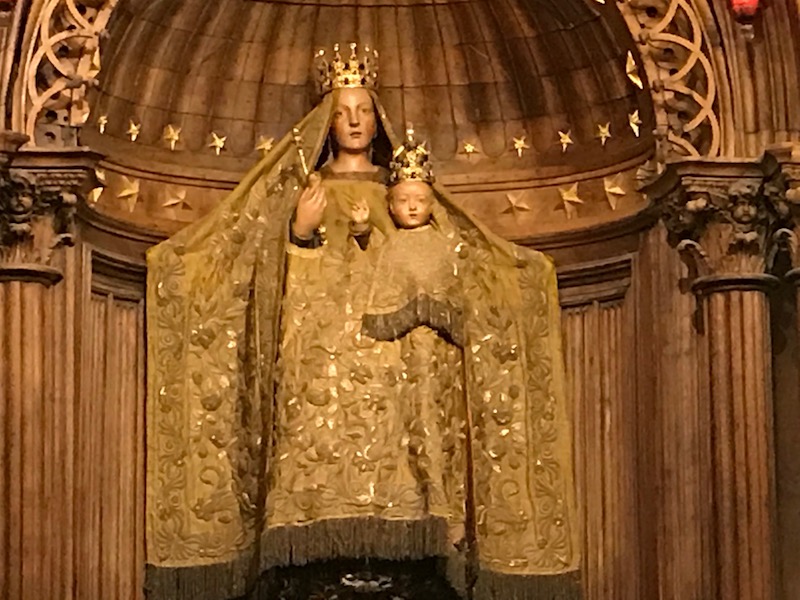
Now we are on to the windows, which are probably what the church is most known for (although the choir screen is amazing). There are 3 rose windows, one over each portal. The rose window on the West side is the oldest, which you can tell from how much non-glass is there. As time went on, innovations allowed for more glass and less stone around the glass.
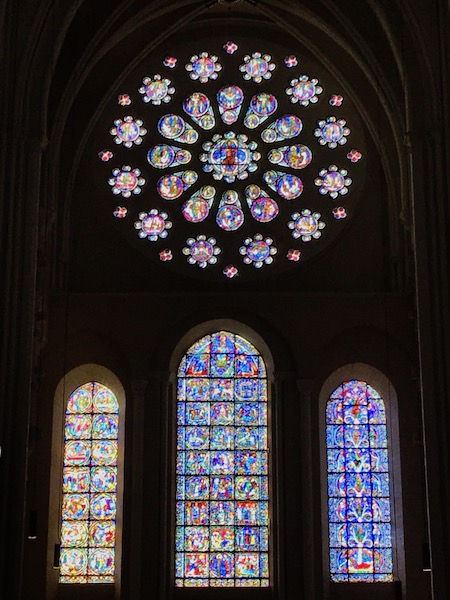
There are actually 4 windows on the West side: the Rose window, and then below it from left to right, x, y, and the Jesse window. The rose window dates to 1215, is 12 meters in diameter, and shows the Last Judgement. In the center, you have Christ as judge surrounded by an inner ring with angels and the elders of the Apocalypse, and the an outer ring showing the dead emerging from their tombs and the angels blowing trumpets to summon them to judgement. The three windows below this rose window are 3 of the 4 Romanesque glass windows that were originally created around 1145 and survived the fire of 1195. These depict the Passion window (left, 1st picture below), the Infancy of Christ (center, 2nd below), and a Tree of Jesse (right, 3rd below).
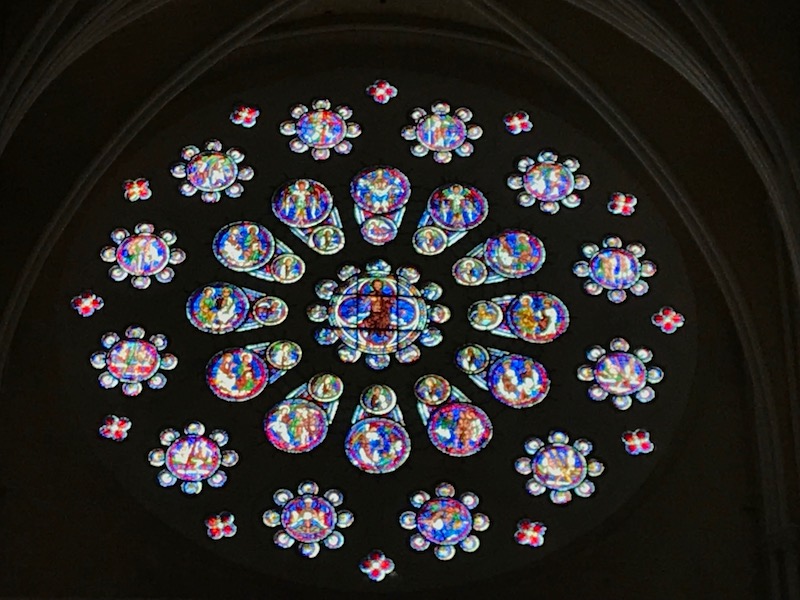
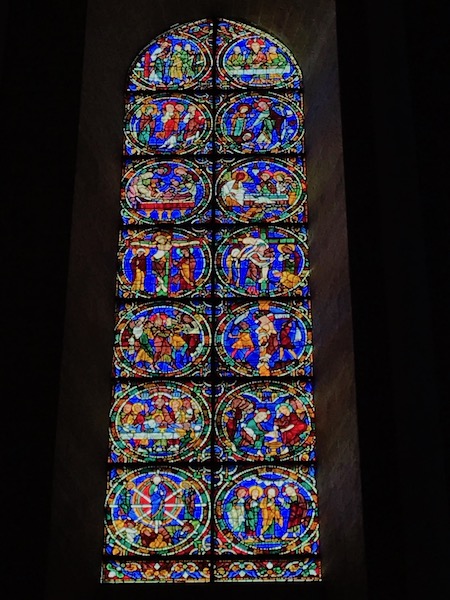


South transept rose window, c.1221-30. The South rose window dates between 1225 and 1230 and is 10.5 meters in diameter. It is dedicated to Christ who is shown in the center surrounded by angels. Two outer rings of twelve circles each contain the 24 Elders of the Apocalypse, crowned and carrying phials and musical instruments. Below the rose window are 5 lancet windows: The central lancet beneath the rose shows the Virgin carrying the infant Christ. Either side of this are four lancets showing the four evangelists sitting on the shoulders of four Prophets – a rare literal illustration of the theological principle that the New Testament builds upon the Old Testament.

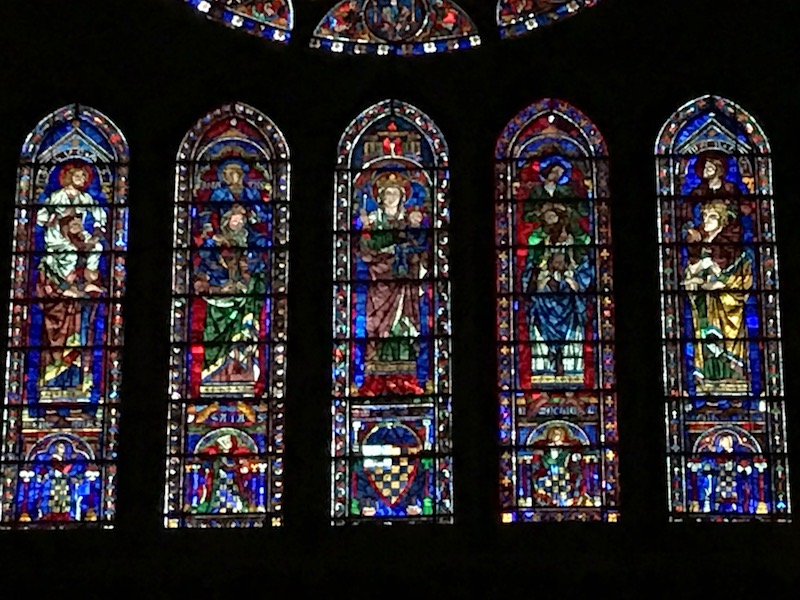
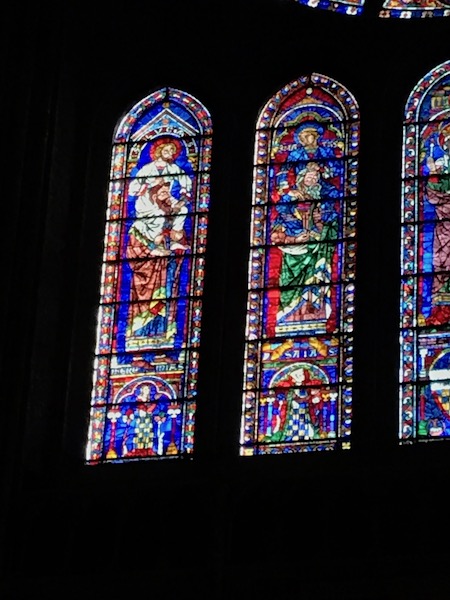
North transept rose window, c.1235. The North rose window was made in 1235 and is also 10.5 meters in diameter. It follows the theme of the north porch and is dedicated to the Virgin Mary. In the center, you have Mary and child surrounded by an inner ring with 4 doves and 8 adoring angels carrying candlesticks. Then is a ring of the Old Testament kings of Judah, another ring of smaller lozenges containing the arms of France and Castille, and finally a ring of semicircles containing Old Testament Prophets holding scrolls.
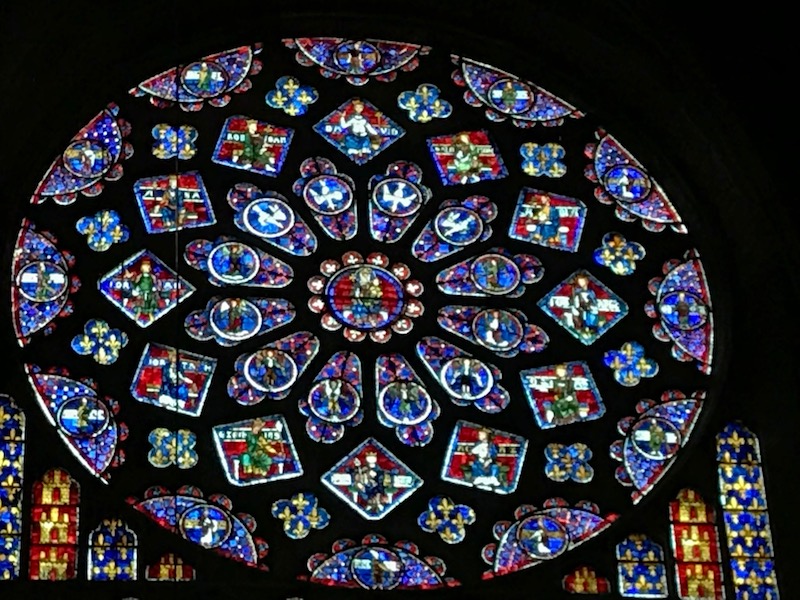

The Vendome Chapel was inserted between two buttresses of the nave in the early 15th century, and contains a late-gothic window. In bottom row, you can find the coats of arms of the donors, Louis de Bourbon, Count of Vendome, and family portrayed above with their patron saints. In the top row, St John Baptist, The Coronation of the Virgin, and St John.
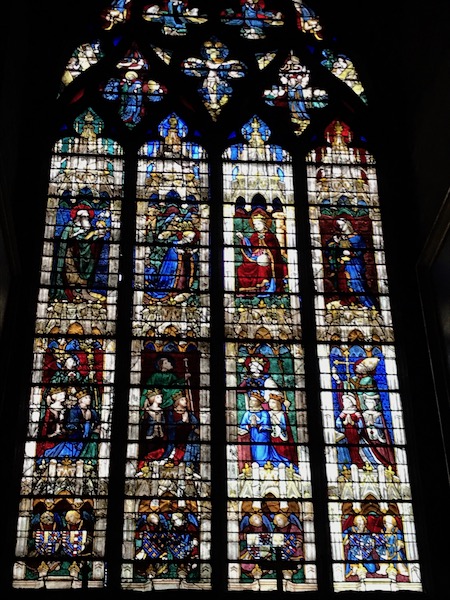
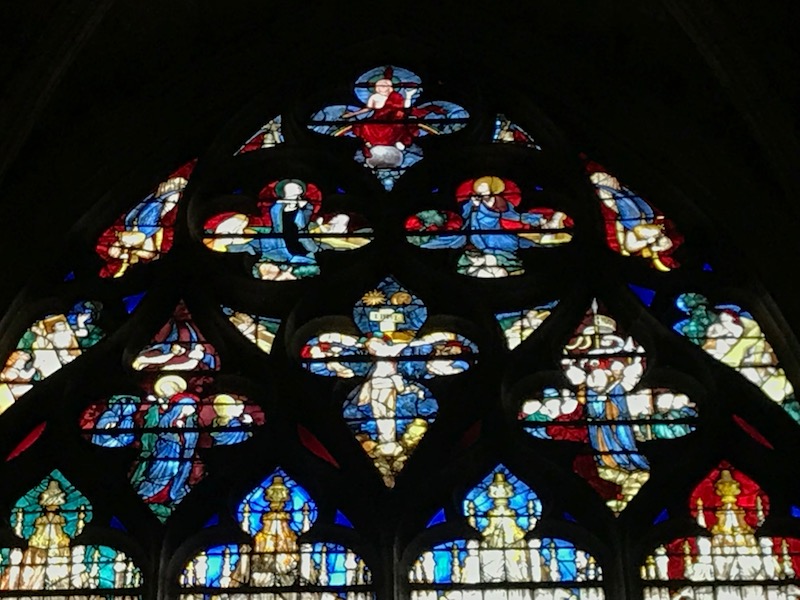

Several of the windows at Chartres include images of local tradesmen or laborers in the lowest two or three panels, often with details of their equipment and working methods. Traditionally, it was claimed that these images represented the guilds of the donors who paid for the windows and this is what the audioguide says. However, there are factions who do not believe this, as the laborers would not have had enough money to actually pay for these windows and, instead, this was an attempt for the church to emphasize that they were a church for everyone, not just the wealthy.

And then back to Paris for dinner. Tonights we are at a restaurant called Semilla, which is also in the top 5 of Modern & Creative restaurants on the Paris by Mouth website. I have to agree with them, everything was really well done. It is quite a large restaurant by Paris standards, with an open kitchen. We had almost the best seats in the house with a good view of the kitchen. In addition to several chefs, there was also a pastry chef who went about her own business on one side of the kitchen. There was also a white Jack Russell Terrier (which I think are the most popular dogs in France) that had come in and was at the table behind us. Yes, many restaurants in France allow dogs inside (as long as they are well behaved). We were lucky enough to have one dog behind us, and another that came in and sat under the table right next to us. Anyway, Tom was attempting to get pictures of the Jack Russell Terrier through a wrought-iron divider.





The menu was a little bit odd here .. it was organized more by how the dish is cooked rather than starter or main. For example, the sections were Raw, Steamed at soup, Cheeses, Oven, and Grill. We started with one raw dish: a ceviche of Daurade (a fish) with tapioca and citrus along with an avocado cream, and one soup: a butternut cream soup with raw cream and granola. Another case where the soup came in two pieces, with the cream and granola in the bottom and then they poured the butternut cream soup in the bowl at the table.

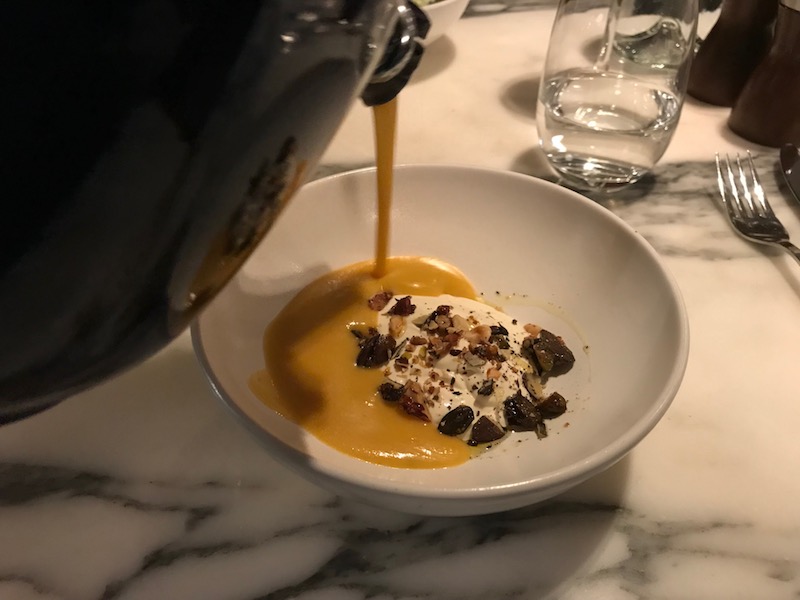
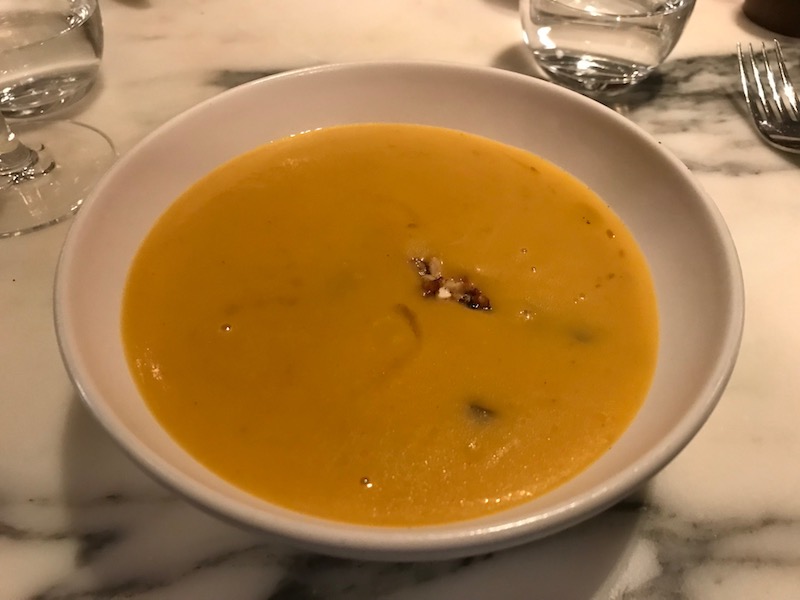

For the main course, we both went with seafood. I went with steamed scallops with yellow wine, crunchy endives, and little tiny cubes of potato. The server actually somewhat warned me that the size of the dish was a bit small, but it really was not, and it was more than enough food along with the soup starter. Tom had a grilled Cod with an aioli and crunchy vegetables.


And of course, we added dessert! Keeping with the winter squash theme, I ordered the candied red kuri squash with a saffron and passion fruit cream and caramelized pecans. This was probably one of the best desserts all week for me. Tom went with a malted barley cream, a chocolate cookie, and a sorbet with cocoa and whiskey.
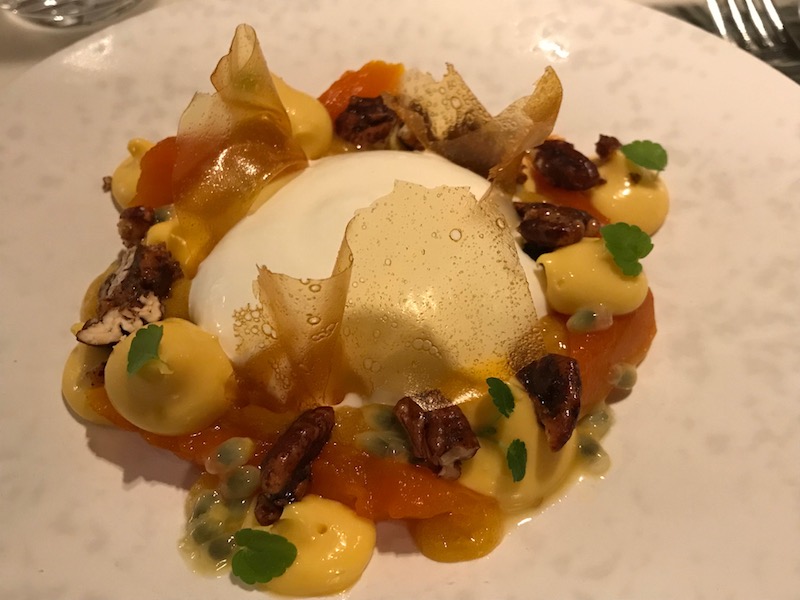

As we walked home, we took the opportunity to take a few pictures from the Seine at night.




Continue to Paris 2018 Day 5